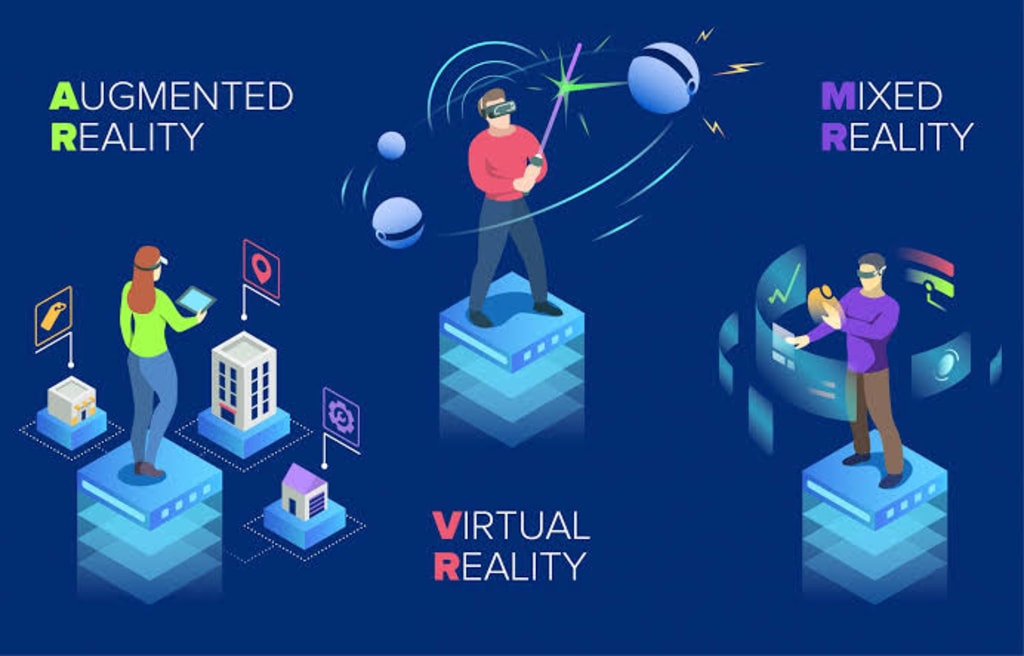Virtual reality and Augmented reality
Imaginary world

"How Virtual Reality and Augmented Reality Work"
VR and AR Head-Mounted Displays (HMDs)
VR HMDs: fully enclose the user's field of view, creating a fully immersive experience
AR HMDs: overlay digital content on the real world, enhancing the user's view of the environment.
Tracking Systems
VR/AR systems use sensors and cameras to track the user's movements and position.
This information is used to update the VR/AR environment in real-time, providing a seamless experience.
Input Devices
VR systems typically use handheld controllers to allow users to interact with the virtual environment.
AR systems may use handheld controllers, gestures, or voice commands for interaction.
Software and Content
VR and AR environments are created using specialized software and content development tools.
High-quality 3D graphics and sound are essential for creating immersive VR/AR experiences.
Display Technologies
VR HMDs use high-resolution displays and lenses to create the illusion of depth and provide a clear image.
AR systems use transparent displays and advanced image processing techniques to overlay digital content on the real world.
"Virtual Reality and Augmented Reality: The Future of Technology"
Definition and differences between VR and AR
Applications in gaming, entertainment, education, and healthcare
Advancements in hardware and software
Limitations and challenges
Ethical considerations and potential impact on society
Future possibilities and advancements in VR and AR technology.
"The Benefits and Limitations of Virtual Reality and Augmented Reality in Education"
Enhancing learning experience through immersive environments
Providing hands-on experience in various fields
Accessibility to resources and information
Limitations in terms of cost and availability of VR/AR equipment
Potential impact on social skills and interaction
Challenges in creating engaging and effective VR/AR educational content.
"Impact of Virtual Reality and Augmented Reality Technology"
Entertainment and Gaming
VR and AR are transforming the gaming and entertainment industries by providing more immersive experiences.
Education and Training
VR and AR are being used to enhance education and training by allowing students to experience hands-on learning in virtual environments.
Healthcare
VR and AR are being used to improve patient outcomes and reduce costs in various healthcare applications such as pain management, therapy, and surgery simulation.
Business and Industry
VR and AR are being adopted by various industries for product design and prototyping, training and simulation, and virtual events and meetings.
Society and Culture
VR and AR have the potential to change the way people interact, socialize, and consume media, potentially leading to new cultural norms and behaviors.
Ethical and Privacy Concerns
The use of VR and AR raises ethical and privacy concerns such as the impact on human behavior and the potential for misuse of personal information.
"Negative Impacts of Virtual Reality and Augmented Reality Technology"
Addiction and Escapism
Overuse of VR and AR can lead to addiction and escapism, reducing real-world interactions and potentially leading to social isolation.
Health Concerns
The use of VR and AR can have physical and psychological effects, such as eye strain, motion sickness, and anxiety.
Privacy Concerns
The collection and use of personal information through VR and AR devices raises privacy concerns and the potential for misuse of sensitive information.
Economic Disparities
The cost of VR and AR devices and content can create economic disparities, limiting access for lower-income individuals and communities.
Ethical Concerns
The use of VR and AR raises ethical concerns such as the potential for creating and perpetuating harmful stereotypes, and the impact on human behavior and decision-making.
Impact on Physical Movement
Excessive use of VR and AR can lead to a reduction in physical activity, potentially impacting physical health and development.
"Conclusion: Virtual Reality and Augmented Reality Technology - A Double-Edged Sword"
Virtual Reality (VR) and Augmented Reality (AR) technology have the potential to transform various aspects of our lives, including entertainment, education, healthcare, and industry. However, the rapid pace of development and adoption also brings with it a range of negative impacts that must be considered and addressed.
From addiction and escapism to privacy concerns and economic disparities, VR and AR technology have the potential to change our lives in ways that are both positive and negative. It is essential that we carefully consider the potential consequences of this technology and take proactive steps to minimize negative impacts and maximize positive outcomes.
Overall, the future of VR and AR technology is promising, but it will require a collaborative effort between developers, users, and policymakers to ensure that it is used in responsible and ethical ways





Comments
There are no comments for this story
Be the first to respond and start the conversation.